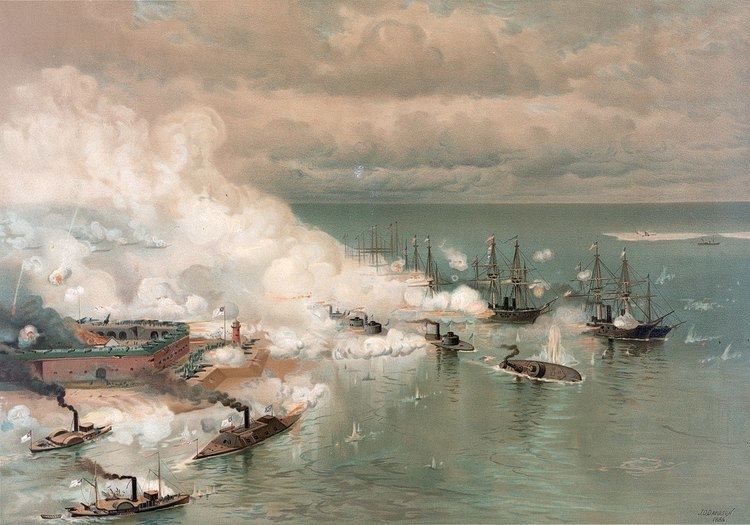 | ||
The naval battles of the American Civil War, fought between the Union and the Confederacy, changed the foundations of naval warfare with the first use of ironclads and submarines, and the introduction of newer and more powerful naval artillery.
Contents
The first shots of the naval war were fired on April 13, 1861, during the Battle of Fort Sumter, by the US Revenue Cutter Service cutter USRC Harriet Lane. The final shots were fired on June 22, 1865, by the Confederate raider CSS Shenandoah in the Bering Strait, more than two months after General Robert E. Lee's surrender of the Confederate Army.
Significant battles
One of the most important and famous naval battles of the Civil War was the clash of the ironclads, between the USS Monitor and the CSS Virginia at the Battle of Hampton Roads. The battle took place on March 8, 1862, and lasted for several hours, resulting in a tactical draw. These revolutionary new warships were protected by the thick armor plating that gives them the name Ironclad, which prevented any lasting damage to either ship.
A second great naval battle occurred at Charleston, South Carolina, in 1863. In this battle, called the First Battle of Charleston Harbor, the Union sent Admiral Du Pont with 9 ironclads to attack Charleston. When given the order, the Admiral did not expect to be victorious. He would have to steer his ships upriver to the fort and attack it from a standstill, giving the Confederates a valuable edge. The Union Naval Force was forced to retreat within two hours to prevent too many casualties in a single battle, which would irreparably cripple the navy. Because of this failure, the Union would be blockaded for two more years, and the Confederacy was able to set up several more forts along the coast of South Carolina.
The Battle of Cherbourg was an intense naval battle that ended in the sinking of the CSS Alabama, one of the best Confederate ships in the fleet, by the USS Kearsarge. The Alabama fired the first shot, but the Kearsarge was slightly faster, had more firepower, and was manned by a larger crew than the Alabama, giving the Union the advantage. The Confederate ship took many hits and casualties, and the rising water shut off its engines, leaving the surviving crew with no other choice but to surrender and be rescued by the Kearsarge.
Other purposes
The navies on both sides not only engaged in battle, but also transported foot soldiers, equipment, and supplies. Without a navy, neither army would have had the supplies or manpower necessary to successfully carry out the war.
Thus, one major strategy of the Union navy involved blockading Southern ports, preventing the South from receiving supplies or aid from allies via shipping ports. Vital supplies such as food, water, ammunition, guns, clothes, and medical supplies never made it to the Confederate troops. The South retained a sufficient amount of resources to withstand the blockade for an extended period of time, causing the war to last longer than expected. However, the blockade continued to prevent the Confederate troops from replenishing their supplies, which in part led to their eventual surrender.
Naval ships on both sides also served as much-needed floating hospitals, housing and treating soldiers who had been injured in battle.
